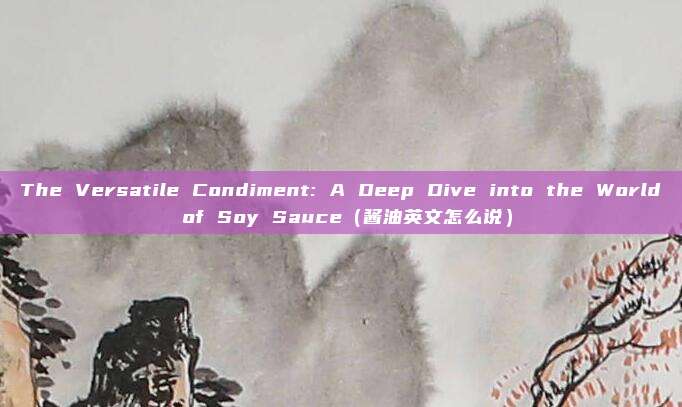The Versatile Condiment: A Deep Dive into the World of Soy Sauce(酱油英文怎么说)
温馨提示:这篇文章已超过219天没有更新,请注意相关的内容是否还可用!
Introduction:
In the culinary world, there are few ingredients as iconic and versatile as soy sauce. Known as "酱油" in Chinese, this dark, savory liquid is a staple in Asian cuisine, adding depth and umami to a wide array of dishes. This article delves into the history, production, types, and uses of soy sauce, offering a comprehensive guide to this essential condiment.
The History of Soy Sauce:
The origins of soy sauce can be traced back to ancient China, where it was first produced around 2,800 years ago. Made from fermented soybeans, wheat, salt, and water, soy sauce has been a key component of Chinese cuisine for centuries. Over time, its popularity spread to neighboring countries, where it has been adapted to suit local tastes and cooking styles.

Production Process:
The production of soy sauce is a complex process that involves several stages. First, soybeans and wheat are ground into a paste and mixed with water and salt. This mixture is then allowed to ferment for several months, during which time it is regularly stirred to prevent mold growth. After fermentation, the mixture is cooked, cooled, and then aged for an additional period, which can range from a few months to several years. The longer the aging process, the richer and more complex the flavor of the soy sauce.
Types of Soy Sauce:
There are many different types of soy sauce available, each with its own unique flavor profile. Some of the most common include:
1、Light Soy Sauce (生抽): This is the most common type of soy sauce and is characterized by its light color and slightly sweet, salty taste. It is used in a variety of dishes, from stir-fries to marinades.
2、Dark Soy Sauce (老抽): Dark soy sauce has a richer, darker color and a more robust, savory taste. It is often used to add color and depth to sauces and stews.
3、Tamari Sauce: Tamari is a type of soy sauce that is made without wheat, making it suitable for those with wheat allergies or gluten sensitivities. It has a nuttier, more intense flavor than regular soy sauce.
4、Shoyu Sauce: Shoyu is a Japanese version of soy sauce that is similar to light soy sauce in terms of flavor and color.
5、Teriyaki Sauce: While not a soy sauce itself, teriyaki sauce is a sweet and savory sauce made with soy sauce as a base, often used for grilling and basting meats.
Uses of Soy Sauce:
Soy sauce is an incredibly versatile ingredient that can be used in a variety of ways:
1、Seasoning: Soy sauce is a key ingredient in many Asian dishes, adding a rich, savory flavor to meats, vegetables, and seafood.
2、Marinades: The umami flavor of soy sauce makes it an excellent choice for marinating meats and vegetables before grilling or roasting.
3、Dressings: Soy sauce can be used to create flavorful dressings for salads and sandwiches.
4、Sauces: Soy sauce is a foundational ingredient in many Asian sauces, such as teriyaki, sweet and sour, and black bean sauce.
5、Condiments: Soy sauce is often served as a condiment alongside dishes, providing a quick and easy way to add flavor.
Conclusion:
Soy sauce, or "酱油," is more than just a condiment; it is a cornerstone of Asian cuisine. Its rich history, diverse types, and numerous uses make it an essential ingredient for any kitchen. Whether you're a seasoned chef or a home cook looking to expand your culinary repertoire, understanding the world of soy sauce can open up a world of delicious possibilities.
网站文章、图片来源于网络,以不营利的目的分享经验知识,版权归原作者所有。如有侵权请联系删除!





还没有评论,来说两句吧...